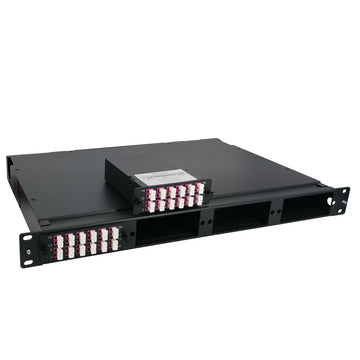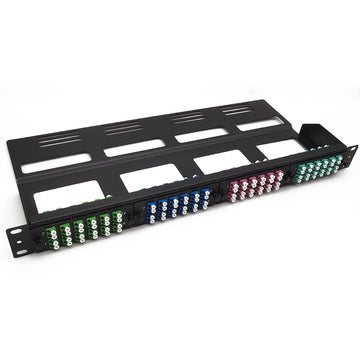What is a passive optical network (PON)?
Introduction of PON
PON stands for Passive Optical Network. A PON is a telecommunications network that transmits data over fiber-optic lines. It is "passive" since it uses passive optical splitter to route data sent from a central location to multiple destinations.
PONs are used by ISPs and NSPs as a cost-effective way to provide Internet access for customers. Since PON is a point-to-multipoint (P2MP) system, which provides a more efficient way to transmit data than a point-to-point network.
The main transmission line can split off into 32 separate lines, which requires far less infrastructure than building direct lines to each destination with fiber optical cabling.
The central location of a PON is also called OLT (optical line terminal), while the individual destination is called ONU (optical network unit).
Types of PON
While all PON use optical fibers and unpowered splitters, there are several different versions. Below is a list of different types of PON.
- APON: It refers to ATM PON. ATM is a transmission protocol based on cells. It can provide dynamic bandwidth allocation for the access network, which helps better meet the demands of broadband data services.
- BPON: It means Broadband PON. It's developed based on APON, which supports transmission rates of 622Mbps. More functions like dynamic bandwidth allocation and protection are provided. It supports services such as Ethernet access, video transmission, and high-speed leased lines.
- EPON: It refers to Ethernet PON. EPON standard is published by IEEE802.3 EFM. It combines Ethernet with PON technologically, adopting PON at the physical layer and Ethernet protocol at the data link layer, and achieving Ethernet access with the topology of PON.
- GPON: The full form is Gigabit PON. It's the latest standard of PON access, which is of high bandwidth, high efficiency, large coverage, and abundant interfaces. GPON is considered the ideal technology for achieving access networks.
PON Architecture
PON networks adopt a Point-to-multipoint (P2MP) architecture which utilizes optical splitters to divide the downstream signal from a single OLT into multiple downstream paths to the end users, the same splitters combine the multiple upstream paths from the end users back to the OLT.
Point-to-multipoint was selected as the most viable PON architecture for optical access networks with the inherent efficiencies of fiber sharing and low-power consumption. This architecture was standardized in 1998 via the ATM-PON G.983.1 specification.
Today, the ITU-T G.984 standard for G-PON has supplanted the ATM standard, since Asynchronous Transfer Mode (ATM) is no longer utilized.
A PON network starts with the optical line terminal (OLT) at the service provider source location typically known as a Local or Central Office, or sometimes referred to as an exchange or headend. From there, the fiber-optic feeder cable (or feeder fiber) is routed to a passive splitter, along with a backup fiber if one is used. Distribution fibers then connect from the splitter to a drop terminal, which can be located in a street cabinet or in a ruggedized housing mounted in a pit, on a telegraph pole or even on the side of buildings. Drop fibers then provide the final one-to-one connection from drop terminal port to an end user ONT/ONU. In some cases, more than one splitter is used in series, this is referred to as a cascaded splitter architecture.
How does a passive optical network work?
A PON system consists of an optical line terminal (OLT) at the communication company's central office and several optical network units (ONUs) near end users. Typically, up to 32 ONUs can be connected to a single OLT. The word passive simply describes the fact that optical transmission has no power requirements or active electronic parts once the signal is being transmitted across the network. This is in contrast to active optical networks, which require electrically powered switching hardware to pass cells or frames across the fiber cabling.
This image shows how redundant OLT hardware commonly sits in the telecommunications service provider's central office. From there, fiber cabling is distributed up to 20 kilometers from the central office and is split into multiple ONUs using a passive optical splitter, which terminates the fiber connection close to the customer's demarcation point. The ONU will then deliver a network handoff using copper or fiber Ethernet cables, making it easy for customers to connect to their existing local area networks (LANs).
Application of PON
Lines that terminate outside buildings are called fiber-to-the-neighborhood (FTTN) or fiber-to-the-curb (FTTC). Lines that extend all the way to buildings are called fiber-to-the-building (FTTB) or fiber-to-the-home (FTTH).
A PON is sometimes referred to as the “last mile” between the provider and user, or the Fiber to the X (FTTX) with “X” signifying the home (FTTH), building (FTTB), premises (FTTP) or other location, depending on where the optical fiber is terminated. Thus far, fiber-to-the home (FTTH) has been the main application for PON.
The reduced cabling infrastructure (no active elements) and flexible media transmission attributes of passive optical networks have made it an ideal fit for home internet, voice and video applications. As PON technology has continued to improve, the potential applications have expanded as well.
The rollout of 5G continues, and PON networks have found a new application with 5G fronthaul. The fronthaul is the connection between the baseband controller and the remote radio head at the cell site.
Due to the bandwidth and latency demands imposed by 5G, utilizing PON networks to complete the fronthaul connections can reduce fiber count and improve efficiency without compromising performance. In much the same way the source signal is split between users for FTTH, signal from the baseband units can be distributed to an array of remote radio heads.
Additional applications that are well suited to passive optical networks include college campuses and business environments. For campus applications, PON networks produce discernable advantages with respect to speed, energy consumption, reliability and access distances but mostly cost of build/deployment and on-going operation.
PON enables integration of campus functions such as building management, security and parking with reduced dedicated equipment, cabling and management systems. Similarly, medium to large sized business complexes can reap immediate benefits from PON implementation, with the reduced installation and maintenance costs directly impacting the bottom line.
What are the benefits and limitations of PONs?
Benefits of PONs include the following:
- They are cheaper to deploy compared to most alternative broadband delivery technologies.
- They do not require electrically powered midspan devices to operate.
- They use existing fiber optic
- Their upgrade paths are plentiful, and throughput rates are keeping up with alternative technologies.
- They are considered a secure broadband technology.
- They can be transported over relatively long distances, such as 20 kilometers, on a central office loop.
The potential drawbacks of passive optical networks include the following:
- They require an extensive fiber deployment.
- Larger networks can become less efficient due to the amount of management traffic overhead being transported from the central office to individual customer ONUs.
- Unlike active powered network technologies, PONs must adhere to strict transport distance limitations.
Conclusion
Overall, the inherent benefits of passive optical networks substantially outweigh these limitations.
As PON technology continues to improve, the strategic and economic advantages of PON deployment become more compelling. The challenges being addressed by designers of future generations include improved range capability and higher splitter ratios to reduce cable outlay even further. These improvements, combined with speeds now reaching 10 Gbps and beyond, will help to continue the expansion of passive optical networks into the smart cities, universities, hospitals and corporations that make up the connected world of tomorrow.












